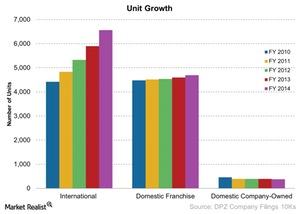Domino’s Pizza Enjoys the Dual Benefits of Vertical Integration
Because Domino’s Pizza sells dough and ingredients to its own franchises, the company derives dual benefits from the supply chain segment.
March 31 2015, Updated 1:06 p.m. ET

The dual benefits
Domino’s Pizza (DPZ) supply chain segment revenue has increased year-over-year, as we discovered in the previous part of this series.
The Consumer Discretionary Select Sector SPDR Fund (XLY) has 1.5% of its portfolio invested in Yum! Brands (YUM) and 4% invested in McDonald’s (MCD). Unlike these restaurant chains, Domino’s supply chain revenue is vertical. Because it sells dough and ingredients to its own franchises, the company derives dual benefits from the segment.
Papa John’s (PZZA) has a similar reporting segment.
Most Domino’s restaurants are franchised
Domino’s has more franchised stores than company-owned stores. In its company filings, Domino’s calls itself primarily a franchise business. But rather than just earning royalties from franchises, the vertical supply chain also benefits from franchise unit growth.
Over a five-year period, Domino’s added 218 domestic franchises and 2,140 internationally. The vertical supply chain segment, which reports consolidated revenue from domestic and international markets, grew 31% over the same period.
All of Domino’s international stores are franchised. As of fiscal 2014, Domino’s had 6,562 restaurants abroad. These franchises paid $152.6 million in royalties and fees, representing 8% of Domino’s revenue in 2014.
According to company filings, the majority of these international restaurants operate under master franchise agreements. We’ll discuss the master franchise model in more detail later in this series.
Company-owned stores
Domino’s Pizza has very few company-operated stores in comparison. As of fiscal 2014, the company had only 377 stores in the US. In fact, the company has been reducing the number of domestic stores. In the same five-year period, it reported 77 fewer domestic company-operated stores. The company-owned stores nonetheless earned $578 million or 29% of Domino’s revenue in 2014.
In the next part of this series, we’ll look more closely at how the company-owned stores have performed over years.
